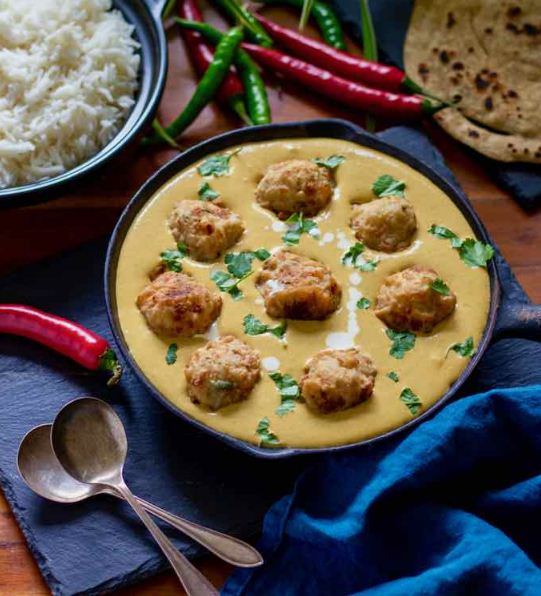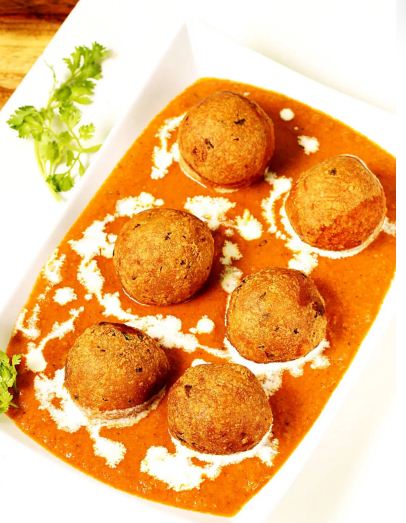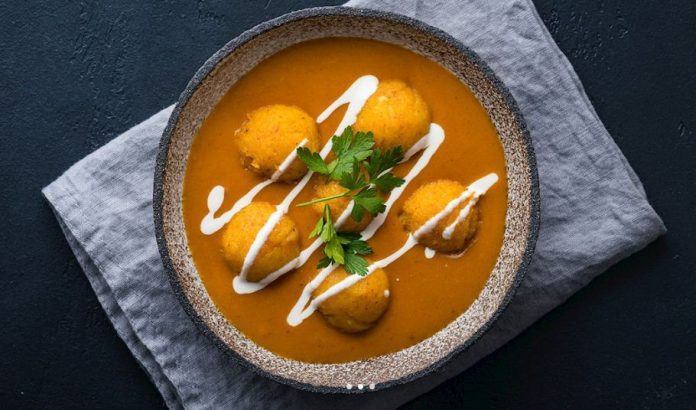By Foodie
Malai Kofta is a highly rich, delicious, creamy savoury dish best served at parties and special occasions. Malai kofta is a north Indian specialty originated from the Mughlai cuisine. It is an authentic dish from the Mughlai recipes and popular in many restaurants around the world.
Malai kofta is the best vegetarian dish alternative to meatballs. It goes extremely well with naan or Jeera rice. Malai refers to the cream and the Kofta are deep fried mixed veggie dumplings mixed in a spicy onion, tomato and cream gravy that delights each and every bit of your taste buds.
There are two popular variations of Malai Kofta: The Mughlai version and the Punjabi version.
The Punjabi version:
Kofta are a favourite with Punjabis and kofta are made with nearly any vegetable. Potatoes are usually used for binding the kofta, which may be flavoured with a variety of Punjabi spices. The gravy in which the kofta are doused also vary. The Punjabi Malai Kofta is a specialty and savored by all connoisseurs of Punjabi food. Spicy and soft vegetable dumplings are put into a rich tomato gravy cooked in butter and topped with cream.


Ingredients
Punjabi Malai Kofta :
Gravy Prep Time: 20 minutes | Cook time: 30 minutes | Serves: 6-8 FOR GRAVY
- Red chilli powder – 1 tblspn
- Garam Masala – 1 tsp
- Turmeric Powder – 1/3 tsp
- Ginger Garlic Paste – 1 tbls
- Oil – as Required
To Grind
- Tomato – 4 Medium nos
- Onion – 3 Medium nos
- Cashews – 20 nos (soaked in hot water for 10 mins)-To Temper
- Bay Leaf – 2 nos
- Green Cardamom – 2 nos
- Cloves – 6 nos
- Cinnamon – 2 nos
Preparation:
- Prepare all the items required for gravy. Soak the cashews in hot water for 10 mins.I didn’t get the medium size onion so i have taken one big onion and one medium.Chop the tomatoes and onion and keep them separately.
- Take tomato puree by grinding the tomatoes, make sure the tomatoes you select are not very sour ones. Grind the onion and cashews separately, if you don’t have ginger garlic paste you can also grind them along with onion. If you prefer you can add 1 green chilli also along with it.
- Heat a pan and add oil, add the items under TO TEMPER in it(Crush the green cardamom and add). Then add the onion paste and fry it until raw flavor goes.
- Once the onion changes color add ging.
- Then add all the powders mentioned under GRAVY above and fry it for 2 mins.
- Add water (about 1.5 cups) inside the mixture and allow it to boil until the oil separates from the mixture.
- When oil separates from the mixture it indicates all the ingredients are cooked well, now you can add the cream . Color of the gravy will change from red to bright orange. Then you can add the powdered/crushed kasuri methi leaves about 1 tbsp.
Kofta preparation
- Grate the paneer using a grater and boil 3 medium size potatoes. Remove the skin of the potato. Take all the nuts that have you at home, this is required for stuffing the kofta.
- Take a bowl, mash all the potatoes, add the grated paneer to it . Add all the dry powders, flour mentioned under kofta and mix everything well and make it like a dough. Make a round ball, flatten it and stuff the chopped nut and make either a round ball or cylinder.
- Heat oil in a pan, add the kofta and fry all the sides until it turns golden brown.
- Transfer it to serving bowl add kofthas only before serving
Mughalai version
It has mild, slightly sweet, aromatic white gravy. This dish has an elaborative process of cooking in two stages. First stage is to prepare the rich creamy gravy and the second stage is to prepare the kofta itself. Kofta was prepared using meat during the Persian and Mughal period, later it was adopted and the same process was used to fuse different vegetables. Most popular combination is aloo and paneer, both have a very soft texture which melts in the mouth like butter.


It’s aptly an authentic Mughlai delicacy. Mughlai food is characterized by rich and creamy curry which have a distinct aroma and taste of ground and whole spices. There are many versions of Kofta but most of them mistake it for the paneer (cottage cheese) stuffing but it’s actually the mixed vegetable with grated paneer that are made into koftas.
The dish is often prepared in a unique wok called a kadai, hence the other name of the dish, kadai kofta. Some food historians believe that these deep-fried dumplings have incorporated the influences of Turkish and Persian food cultures within them.
Ingredients
Prep Time: 30 mins
Cook Time: 40 mins
Total Time: 1 hr 10 mins
For the tomato purée with onion
- 1 tablespoon vegetable oil
- 1 large onion , finely diced
- 3 large tomatoes , peeled, seeded and diced
- 15 cashew nuts
- 3 green cardamom pods
- 1 cinnamon stick (optional)
- 3 cloves (optional)
For the curry sauce - 2 tablespoons clarified butter (ghee)
- 2 tablespoons vegetable oil
- 1 Indian bay leaf (tej patta)
- 1 cinnamon stick (optional)
- 2 green cardamom pods
- 1 teaspoon garlic paste
- 1 teaspoon ginger paste
- 1 teaspoon red chili powder
- 1 teaspoon garam masala
- 1 teaspoon ground coriander seeds
- 1 tablespoon dried fenugreek leaves (kasuri methi)
- 1 teaspoon sugar
- ½ cup water
- 4 tablespoons heavy cream (malai)
- 1 teaspoon salt
For the kofta - 5 oz. paneer (Indian cheese), crumbled
- 2 boiled potatoes
- 2½ tablespoons cornstarch
- 1 teaspoon ginger paste
- 2 tablespoons finely chopped cilantro leaves
- ¾ teaspoon garam masala
- 1 tablespoon chopped cashews (optional)
- 1 tablespoon raisins (optional)
- Salt
- 4 tablespoons Vegetable oil (for frying)
How to make :
Kofta preparation: - Firstly, in a large mixing bowl take 3 potatoes and ¾ cup paneer.
- Also add 1 chilli, 2 tbsp coriander, ¼ tsp cumin powder and ½ tsp salt.Add 2 tbsp raisins and 2 tbsp cashew to have crunchy bite in kofta.
- Mix well making sure all the spices are well combined
- Now add 2 tbsp maida and mix well forming a soft dough. maida helps to absorb moisture and bind the mixture well.
- Prepare a small ball sized kofta by greasing your hand with oil.
- Deep fry on medium hot oil.
- Stir occasionally, making sure the koftas are cooked uniformly.
- Fry until the kofta turns golden brown and crisp.
- Drain off the koftas and keep aside.
Curry preparation for malia kofta:
- Firstly, in a pan heat 2 tbsp oil and saute 1 onion, 1 tsp ginger garlic paste.
- Saute until onions changes colour slightly.
- Further add 2 tomato and saute slightly.
- Now add 2 tbsp cashew and continue to saute until tomatoes soften completely.
- Cool completely and transfer to a blender.
- Blend to smooth paste adding water if required.
- Now filter the mixture to get rid of skin and seeds.
- Filter until silky smooth onion-tomato puree is attained. keep aside.
- In a large kadai heat 1 tbsp butter and 2 tbsp oil.
- Saute 1 tsp cumin, 2 pod cardamom, 1 bay leaf, 1 inch cinnamon, 2 clove until it turns aromatic.
- Further keeping the flame on low, add 1 tsp chilli powder, ½ tsp turmeric, ¾ tsp coriander powder and ¼ tsp cumin powder.
- Saute until the spices turn aromatic.
- Further add in the prepared onion tomato puree, 1 tsp salt and mix well.
- Cover and cook until the mixture starts to thicken and oil separates from sides.
- Now add ¼ cup cream and mix on low flame until it’s well combined.
- Further, add ½ cup water and mix well adjusting consistency as required.
- Get the curry to a boil, add 1 tsp kasuri methi and ¼ tsp garam masala. mix well.
- Finally, pour the curry over kofta and malai kofta is ready to enjoy.
HISTORY
The first appearance of recipes for kofta is in the earliest Arab cookbooks. The earliest recipes are for large ground lamb meatballs triple-glazed in a mixture of saffron and egg yolk.This glazing method spread to the West, where it is referred to as “gilding” or “endorsing”. Koftas moved to India; according to Alan Davidson nargisi kofta were served at the Mughal court.
Koftas are found from the Indian subcontinent through Central Asia, the Middle East, the Balkans, and northern Africa.Koftas are found in the traditional cuisines of Iran, Afghanistan,Albania, Bulgaria, Georgia,Armenia, Azerbaijan,Greece,india, Morocco, Pakistan,Romania,and Turkey.
In Turkey it is “a preferred offering at communal gatherings of all kinds”, according to Engin Akin. In Armenia and Azerbaijan it is, along with dolma, lavash, harissa, kebabs, and pahlava, a dish of “clearly symbolic ethnic significance” often argued over by gastro nationalists attempting to claim it as one of their own country’s traditional dishes that has been co-opted by the other country Kofta is a popular dish among Assyrian people.





















